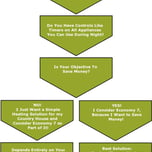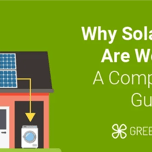Answer these simple questions and we will find you the BEST prices
Which type of solar quotes do you need?
It only takes 30 seconds
100% free with no obligation

Get up to 4 quotes by filling in only 1 quick form

Slash your energy bills by installing solar panels

For the average 2-3 bedroom house
- GreenMatch
- Solar Energy
- A Brief History of Solar Energy
A Brief History of Solar Energy
Solar panels are a relatively new technology, dating back to the 70s. What you might not know is that people have started harnessing the sun’s power a long, long time before that. The history of solar energy spans from so far as the 7th century B. C., and still has enormous potential for growth in the future. Let’s go through some of the main phases of its journey.
Solar energy has a rich and diverse history that highlights its potential to transform the world. Today, it's a reliable and cost-effective way to power your home or business. It's time to take advantage of this technology and make the switch to a cleaner, more sustainable energy source.
Use GreenMatch's free service to get up to 3 no-obligation quotes from reliable installers today and join the millions of people who are already reaping the benefits of solar energy.
- Quotes from local engineers
- Payment by finance available
- Save up to £1,110 per year
It only takes 30 seconds



The Ancient Times: Playing with Fire
If you’ve ever been a kid, you probably have at least once played a little game of burn-the-ants with sunlight and a magnifying glass. And you were not the first one: ancient civilisations from the 7th century B. C. used the same technique to light fires (and torture insects). Greeks and Romans used mirrors to light torches for religious rituals, and even to burn enemies’ ships. Homes and bath houses had strategically placed windows that would let the sunlight in to heat water tanks, or would be built wherever they could catch the most light.
1700 - 1800: Getting to Know the Photovoltaic Effect
In this period, the first patents for solar collectors and solar water heaters started surfacing. In 1839, scientist Edmond Becquerel discovered the photovoltaic effect by experimenting with electrolytic cells: during the process, he realised that more electricity was produced if the cells were exposed to sunlight. Further progress was made in 1876, when a group of scientists discovered that selenium could turn light into electricity without heat. Selenium was then used to create the first solar cell in 1883, and the first commercial solar water heater was patented ten years later.
1900: the Solar Cell and Its Consequences
The first solar collector, which was very similar to those we use today, was produced in 1908, three years after the publication of the paper on the photoelectric effect that won Einstein the Nobel Prize. The scarcity of energy during World War II led to the diffusion of passive solar buildings in the United States and the publication of books about “solar houses” and architects.
Finally, in 1954, the first silicon photovoltaic cell was created, and unlike its selenium predecessor, it managed to generate enough electricity to power electrical equipment. Its solar efficiency only reached 4%, compared to today’s 20%.
After this invention, the first solar-powered devices started hitting the market and solar technologies such as solar water heating began being used for commercial office buildings. One of the most notable applications of early solar cells is satellites: while the commercialisation of solar cells was initially unsuccessful, many satellites built in the second half of the century integrated solar technology smoothly, and it is still being used today.
It was in 1970 that a much less expensive version of the silicon solar cell was introduced, and that marked the beginning of the commercialisation of solar panels. Finally, the option of solar power was not only feasible for large companies and NASA, but it could be used domestically and for small public infrastructures. In the following years, an increasing number of applications of solar energy became a possibility: cars, airplanes, solar farms, thin films and more.
2000: Solar for Everyone
Since the beginning of the century, scientists have been focusing on ways to make solar panels more efficient and convenient. As a result, the technology has become more accessible to everyone. The ultimate goal is to make solar power as cheap as traditional energy sources, since it is still not competitive enough. Transportation, communication, and even clothing might one day be exploiting it in some way. The applications are truly endless.
Nowadays, domestic solar panel systems are much cheaper. So much so, that the UK government decided to retire the Feed-in Tariff in March 2019, due to solar panels becoming affordable enough for homeowners even without the incentive. This makes the future of solar power very promising in the UK.
If you're interested in incorporating solar energy into your life, then getting quotes from reliable installers is the first step. GreenMatch's free service can help you do this. By requesting up to 3 quotes from reliable installers, you can learn about the different options available to you and start saving money on your energy bills.
It all starts with clicking the button below and filling in a 30-second contact form.
- Quotes from local engineers
- Payment by finance available
- Save up to £1,110 per year
It only takes 30 seconds



We strive to connect our customers with the right product and supplier. Would you like to be part of GreenMatch?




